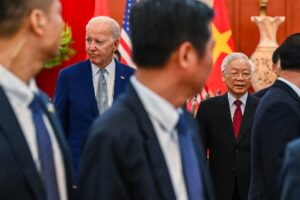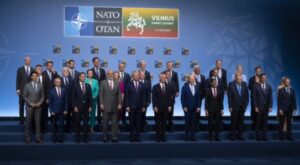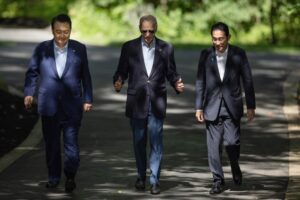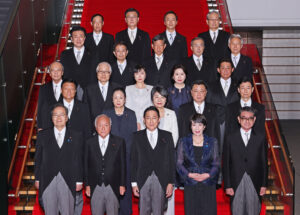Articles
2023 is the year for the US and Japan to intensify their cooperation in multilateral venues. The first opportunity was the G7 meeting in Hiroshima in May, and the last will be the APEC meeting in San Francisco in November. In between, partners were hosting other important meetings: the NATO Summit in Lithuania and the G20 in India. Across these meetings, Russia’s war in Ukraine has stayed at the top of the agenda. The war has focused attention on the rules-based order, but global economic cooperation was not far behind. Prime Minister Kishida Fumio traveled to Africa and the Middle East to offer assistance for food insecurity and to stabilize energy markets, while President Joe Biden reached out to nations in the Indo-Pacific, including Pacific Island nations and Vietnam, to deepen strategic cooperation. China continues to loom large. The Biden administration sent three Cabinet members to Beijing for long sought consultations. Secretary of State Antony Blinken finally realized his planned trip on June 18-19. Secretary of the Treasury Janet Yellen followed on July 6-9 to meet with her counterpart, Vice Premier He Lifeng.
Finally, Secretary of Commerce Gina Raimondo traveled to China on Aug. 27-30 to meet Minister of Commerce Wang Wentao, addressing the difficult challenges of technology and supply chains. Whether these visits achieved a sufficient level of trust remains to be seen.

Figure 1 President Biden meets with Nguyen Phu Trong, the general secretary of the Communist Party of Vietnam, in Hanoi. Photo: Kenny Holston/New York Times
The diplomatic highlight this summer was the trilateral summit between President Biden, Prime Minister Kishida, and South Korean President Yoon Suk Yeol on Aug. 18 at Camp David. Described as “historic,” the scene of these three allied leaders meeting at one of the most celebrated locations in US diplomacy was set carefully by all three leaders. Bilateral strains between Tokyo and Seoul had been tended by shuttle diplomacy by Yoon and Kishida, and the military cooperation between the two US allies had been restored and deepened as North Korea demonstrated the growing sophistication of its missile arsenal. China complained bitterly about this “Cold War mentality,” revealing that the hard work of all three leaders to strengthen their cooperation beyond the Korean Peninsula to the Indo-Pacific had been duly noted in Beijing.
Japan’s G7
Prime Minister Kishida assiduously traveled to visit partners, creating the foundation for a successful G7 summit in Hiroshima. After his early 2023 trip to Europe and North America, Kishida traveled to India on March 20 and to Ukraine the following day to meet President Volodymyr Zelenskyy, the last G7 leader to do so. With an eye to the Global South and its support for the G7, Kishida also traveled to Egypt, Ghana, Kenya, and Mozambique from April 29 to May 4, where he pledged $500 million in assistance to promote peace and stability in Africa. Finally, Kishida focused on relations with South Korea, inviting President Yoon as a special guest to the G7 Summit. A trip to Seoul on May 7-8, the first by a Japanese prime minister in 12 years, cemented the commitment to improving bilateral ties.
The G7 agenda was impressively global. The war in Ukraine was at the top of the list of concerns, of course, with members agreeing to tighten sanctions on Russia. But so too were the concerns over the future of the Indo-Pacific. President Yoon’s presence, together with that of Prime Ministers Anthony Albanese of Australia and Narendra Modi of India, alongside the largely European grouping, reminded the world of the growing convergence and collaboration among the US and its allies and partners. Modi in particular presented a link to the grouping referred to as the Global South, and the leaders of Brazil and regional organizations including the African Union, ASEAN, and Pacific Islands Forum brought a decidedly global feel to the gathering of advanced industrial economies that make up the G7.

Figure 2 The leaders of the four Quad countries take a group photo during the G7 summit in Hiroshima. Photo: AP
Held in Hiroshima, Kishida’s own constituency, the G7 directly addressed the nuclear dimension of the conflict in Ukraine. Signing a declaration, the Hiroshima Vision on Nuclear Disarmament, all seven leaders committed themselves to efforts to reduce the risk that nuclear weapons will be used again and condemned any threats by countries to carry out nuclear tests.
Perhaps the most dramatic moment was the arrival of Ukrainian President Zelenskyy via a French military aircraft. His appearance was certain but initially expected to be a virtual one. He met with Prime Minister Kishida, and they together visited the Hiroshima Peace Memorial to lay wreaths. In a speech on May 21, Zelenskyy said that while it “wouldn’t be fair” to compare the attack on Hiroshima to the war in his own country, “the pictures of ruined Hiroshima really totally remind me of Bakhmut,” a Ukrainian city that Russia claimed to have captured earlier that day. Zelenskyy went on to urge Russian President Vladimir Putin to abandon his “nuclear blackmail of the world.” Equally telling was the meeting held for the first time between Zelenskyy and Modi, signaling Indian support for Ukraine despite its caution toward sanctions on Russia. Modi said India would do “everything we can” to help end the war, calling the war not “just an issue of economy or politics…[but] an issue of humanity.”
President Biden’s trip to Tokyo for the G7 was to be the first stop on a broader Indo-Pacific jaunt that included Australia and Papua New Guinea. Domestic politics in Washington over the debt ceiling led to an abbreviated trip, however. The Quad meeting, originally intended to be hosted by Prime Minister Albanese in Canberra, was held on the sidelines of the G7 and proved to be a much briefer demonstration of the convictions of the Quad leaders. Nonetheless, the Quad continues to expand its agenda for ensuring Indo-Pacific needs are met in a wide range of fields, including climate change, global health, infrastructure, space, cyber, maritime security, and critical and emerging technologies.
Below the headlines of these leaders’ meetings, this G7 meeting produced a notable new effort to coordinate a concerted policy response when one member suffered from economic coercion. A Coordination Platform on Economic Coercion was created to ensure that any member who suffered economic pressures would be able to draw on the support of others to mitigate their impact. This initiative builds on the US Countering Economic Coercion Task Force, established last December and led by the National Security Council, which as part of its mandate seeks to work with US allies to determine how best to respond to Chinese economic pressure.
US Allies Join Hands
Where the G7 began strengthening the diplomatic agenda for European and Indo-Pacific nations, the NATO Summit held in Vilnius, Lithuania on July 11-12 deepened strategic cooperation among US allies. NATO Secretary-General Jens Stoltenberg welcomed Prime Minister Kishida’s participation in the summit, noting that “no other partner is closer to NATO than Japan,” a reflection of the growing strategic ties between Tokyo and US allies in Europe. As NATO leaders gathered to discuss their enhanced security goals in the wake of Russia’s invasion of Ukraine, they reasserted their commitment to collective defense as set out by Article 5 of the Washington Treaty. The Vilnius Summit Communique further reiterated the Russian Federation’s violation of international norms and principles, noting that “peace in the Euro-Atlantic area has been shattered.” But the NATO leaders also acknowledged that threats were global and interconnected, and that “strategic competition, pervasive instability, and recurrent shocks define our broader security environment,” identifying China’s “ambitions and coercive policies” as a challenge to their interests.
Japan’s partnership with NATO is expanding. The Individually Tailored Partnership Programme for 2023-2026 noted Japan’s new national security strategy and defense plan as an important contribution to deepening strategic ties in support of the Rules-Based International Order. Specifically, cooperation between the two will focus on emerging security challenges, including cybersecurity, disruptive emerging technologies, space, maritime security, and climate change. Bilateral security ties and exercises remain central to these goals. Three specific goals were identified: greater dialogue and consultations, enhanced interoperability, and stronger resilience “across the peace-crisis spectrum.”

Figure 3 Leaders and heads of state pose for a group photo at the NATO Summit in Vilnius on July 11, 2023. Photo: Adrian Wyld/AP
On May 3, the Nikkei Shimbun reported that these growing ties between Euro-Atlantic and Indo-Pacific security goals would lead to the establishment of a NATO liaison office in Tokyo. China reacted immediately, with foreign ministry spokesperson Mao Ning saying that the “Asia-Pacific does not welcome group confrontation [or] military confrontation.” She went on to say that Japan should be “extra cautious on the issue of military security [given its] history of aggression.” French President Emmanuel Macron did not seem to be onboard with the idea, stating that NATO should remain focused on the North Atlantic. When asked about the Tokyo office in July, NATO Secretary-General Stoltenberg said the idea was still up for discussion.
At the Vilnius Summit on July 12, Prime Minister Kishida and President Biden also appeared alongside President Zelenskyy to announce the G7 Joint Declaration of Support for Ukraine. After some brief introductory remarks from Kishida, Biden used the opportunity to publicly thank Japan’s prime minister for his country’s aid and assistance to Ukraine. In remarks that seemed unplanned, Biden said that while “very few people” in Europe or North America expected Japan to step up following Russia’s invasion, Kishida had done so because he “understood that when any part of the world has 185,000 people, soldiers crossing a border, stealing sovereignty from another nation, that affects the whole world.”
Japan’s support for Ukraine has continued through the summer. Later in July, reports surfaced that Japan was preparing a new round of defense equipment and infrastructure assistance, including the possible transfer of military communication systems and aid with repairing military and civilian seaports and airports. On Sept. 9, Foreign Minister Hayashi Yoshimasa made a surprise trip to Kyiv to meet President Zelenskyy, where the two agreed to begin negotiations on a security pact. Hayashi brought with him a delegation of Japanese business leaders, which Hayashi said he hoped would “mark the beginning of reconstruction support that only Japan can provide.” In a message posted to X (formerly Twitter), Zelenskyy said he was “confident that the Ukrainian-Japanese partnership will set a global example of how to protect life and create new opportunities for free nations.”
The Camp David Summit
One of the highest priorities of the Biden administration has been the restoration of close trilateral policy coordination between Washington, Tokyo, and Seoul. Early consultations between national security advisors, military leaders, and intelligence heads brought the security agenda into focus, and exercises between the three militaries increased. North Korean missile launches created even more chances to deepen missile and air defense cooperation, and anti-submarine warfare exercises also helped repair their maritime ties.
As President Yoon and Prime Minister Kishida addressed their bilateral challenges, an expanded trilateral agenda emerged. At Phnom Penh last November on the sidelines of the East Asia Summit, the three leaders embraced a new Indo-Pacific framing for their cooperation, revealing progress in aligning their strategic goals beyond the Korean Peninsula. Economic security as well as the stability of the region has increasingly defined their trilateral cooperation. Embedding South Korean and Japanese cooperation in multilateral efforts to support the rules-based international order in the wake of the Russian invasion also cast the trilateral in a global effort to act in concert to demonstrate their shared values. President Yoon’s attendance at the G7 meeting in Hiroshima as well as his participation in the NATO summit provided an opportunity for deepening trilateral policy coordination.

Figure 4 President Biden, Prime Minister Kishida and South Korean President Yoon Suk Yeol walk together to a joint press conference following talks at Camp David. Photo: Chip Somodevilla/Getty Images
On Aug. 18, President Biden hosted Prime Minister Kishida and President Yoon for a trilateral US-Japan-South Korea summit at Camp David. The event marked the fourth meeting of the three leaders, but it was the first-ever stand-alone summit that did not occur on the sidelines of a larger meeting. It was also Biden’s first occasion hosting a foreign leaders’ summit at Camp David, a site renowned for past presidential diplomatic achievements. Notable moments include President Dwight Eisenhower hosting Nikita Khrushchev in 1959, the first time a Soviet premier visited the US, and President Jimmy Carter facilitating the Egyptian-Israeli peace negotiations between Israeli Prime Minister Menachem Begin and Egyptian President Anwar Al-Sadat in 1978.
The trilateral summit resulted in a joint statement dubbed “The Spirit of Camp David,” complemented by separate statements that outlined shared principles and a commitment to consult on regional security threats. In these documents, the three nations vowed to institutionalize annual meetings involving their respective leaders, foreign ministers, defense ministers, national security advisors, and other cabinet-level officials. Furthermore, Biden, Kishida, and Yoon pledged to initiate an annual Trilateral Indo-Pacific Dialogue to better “coordinate implementation of our Indo-Pacific approaches and to continually identify new areas for common action.” This commitment extends to fostering cooperation across a broad spectrum of issues including military exercises, missile defense, economic security, emerging technologies, and development assistance.
Conclusion
While diplomacy drove the US-Japan agenda through a series of important multilateral meetings, politics at home were clearly on the minds of Kishida and Biden. The approval rating of Japan’s prime minister has had a series of ups and downs. The G7 was undoubtedly a boost to Kishida’s popularity, with some polls showing that Kishida’s approval had increased by as much as 9 percentage points and exceeded 50% for the first time this year. Yet, by the end of summer, once again popular frustration with the My Number digital release had removed this year’s gains. By early September, Kishida announced he would reshuffle his Cabinet.
The new Cabinet lineup contained a few surprises. The foreign and defense ministers were replaced. Foreign Minister Hayashi, just back from his trip to Ukraine, was replaced by Kamikawa Yoko, a senior LDP member who had served three stints as minister of Justice. Similarly, Minister of Defense Hamada Yasukazu, was replaced by Kihara Minoru, his first time appointed to the Cabinet. Five women are in this Kishida Cabinet, a boost to female representation in leadership to be sure but not enough yet to redress the gender imbalance. Taro Kono remains as digital minister with the added portfolio of administrative reform. Takaichi Sanae retained her position as minister for economic security. Both were contenders for party leadership. The LDP party leadership also demonstrates the prime minister’s desire to keep potential challengers close. Aso Taro remains as vice president, Motegi Toshimitsu as secretary general, and Hagiuda Koichi as LDP policy chief. Moriyama Hiroshi was appointed chairman of the LDP’s executive council, while Obuchi Yuko, daughter of former prime minister Obuchi Keizo, has been put in charge of the party’s election strategy. The timing of the next election remains to be seen, but with 2025 as his deadline, speculation about Kishida’s ability to shepherd the LDP to a comfortable victory remains.

Figure 5 Prime Minister Kishida poses for a commemorative photo with his newly reshuffled cabinet. Photo: Prime Minister’s Office of Japan
The US presidential election in 2024 is beginning to take shape, raising important questions about the direction of US foreign policy. Republican candidates sans Trump gathered for their first primary debate on Aug. 23 in Milwaukee, Wisconsin and a second debate is scheduled for Sept. 27 in Simi Valley, California. While polling still showed Trump as the favorite for the GOP nominee, the debate provided ample opportunity for others to make their case. As of early September, polling averages put support for Trump at about 55%, followed far behind by Florida Governor Ron DeSantis (14%), businessman Vivek Ramaswamy (7%), former South Carolina Governor Nikki Haley (6%), and former Vice President Mike Pence (5%).
More multilateral coordination lies ahead for the US and Japan on economic security. Their new Economic 2+2 is expected to be held this fall. Indo-Pacific Economic Framework (IPEF) talks continued in Singapore and Busan this summer, followed by Bangkok in September. Close coordination between Secretary of Commerce Raimondo and METI Minister Nishimura Yasutoshi on IPEF, as well as their commitment to implementing the Camp David pledge to establish a new Commerce and Industry ministers dialogue with Seoul, suggest that this interweaving of the US-Japan-South Korea trilateral into broader regional initiatives is bearing fruit. The APEC conference, hosted by the United States in San Francisco in mid-November, will give the Biden administration a chance to showcase progress in this regional economic security effort.
May 1, 2023: President Biden and Philippine President Ferdinand Marcos Jr. release a joint statement in which they mention establishing trilateral modes of cooperation with Japan.
May 12, 2023: Ambassador to Japan Rahm Emanuel releases a video, in which he and 15 foreign ambassadors advocate that Japan embrace LGBTQ rights.
May 13, 2023: Minister of Foreign Affairs Hayashi meets with State Department Counselor Derek Chollet in Stockholm on the sidelines of the EU Indo-Pacific Ministerial Forum.
May 15-Aug. 19, 2023: Japan’s three military branches participate in the US Large Scale Global Exercise 2023 around the Indo-Pacific.
May 18, 2023: President Biden and Prime Minister Kishida meet in Hiroshima ahead of the G7 summit.
May 19-21, 2023: G7 Summit is held in Hiroshima.
May 19, 2023: Minister of Foreign Affairs Hayashi and Secretary of State Blinken meet in Hiroshima on the sidelines of the G7 summit.
May 20, 2023: President Biden, Prime Minister Kishida, Prime Minister of Australia Anthony Albanese, and Prime Minister of India Narendra Modi hold a Quad Leaders’ Meeting in Hiroshima on the sidelines of the G7 Summit.
May 20, 2023: Secretary of State Blinken and MEXT Minister Nagaoka Keiko sign a Memorandum of Cooperation in education.
May 21, 2023: President Biden, Prime Minister Kishida, and South Korean President Yoon Suk Yeol meet in Hiroshima on the sidelines of the G7 Summit.
June 1-7, 2023: US Coast Guard, Japan Coast Guard, and Philippine Coast Guard hold their first ever trilateral maritime exercise in the South China Sea.
June 3, 2023: President Biden signs a bipartisan agreement to raise the debt ceiling and avoid a debt default.
June 3, 2023: Minister of Defense Hamada Yasukazu, Secretary of Defense Lloyd Austin, and Australian Deputy Prime Minister and Minister for Defense Richard Marles hold a Trilateral Defense Ministerial Meeting in Singapore on the sidelines of the Shangri-La Dialogue (SLD).
June 3, 2023: Minister of Defense Hamada, Secretary of Defense Austin, Australian Deputy Prime Minister and Minister for Defense Marles, and Philippine Defense Minister Calito Galvez hold first ever quadrilateral defense ministerial talks in Singapore on the sidelines of the SLD.
June 16, 2023: Japan’s Parliament passes bill addressing anti-LGBTQ discrimination.
June 16, 2023: US Forces Japan and Japan Self-Defense Forces conduct a bilateral aviation integration exercise.
June 16, 2023: National Security Advisor Jake Sullivan, National Security Advisor Akiba Takeo, and Philippines National Security Advisor Eduardo Ano hold their first trilateral national security advisors meeting in Tokyo.
June 17, 2023: Secretary Blinken and Foreign Minister Hayashi speak by telephone.
June 20, 2023: Assistant Secretary of State for East Asia Daniel Kritenbrink meets Vice Minister for Foreign Affairs Mori Takeo, Deputy Minister for Foreign Policy and Director-General for Foreign Policy Bureau Ichikawa Keiichi, and Director-General for Asian and Oceanian Affairs Bureau Funakoshi Takehiro in Tokyo.
June 24, 2023: The G7 Foreign Ministers and EU High Representative for Foreign Affairs and Security Policy speak by telephone about the ongoing situation in Russia.
June 26, 2023: Foreign Minister Hayashi meets a delegation from the House Ways and Means Committee in Tokyo. Representatives include Richard Neal, Adrian Smith, Earl Bulmenauer, Dan Kildee, and Nicole Malliotakis.
June 26, 2023: Prime Minister Kishida meets delegation from the House Ways and Means Committee in Tokyo.
June 26-27, 2023: Deputy Assistant Secretary for the Bureau of Arms Control, Verification and Compliance Alexandra Bell, Deputy Assistant Secretary of Defense and Countering Weapons of Mass Destruction Policy Richard Johnson, Deputy Director-General of the North American Affairs Bureau Miyamoto Shingo, and Deputy Director-General of the Defense Policy Bureau Ando Atsushi hold an Extended Deterrence Dialogue at Whiteman Air Force Base in Missouri.
July 1-12, 2023: Naval forces from the US, Japan, South Korea, and Australia participate in the Pacific Vanguard exercises.
July 3, 2023: Foreign Minister Hayashi meets former Secretary of State Mike Pompeo in Tokyo.
July 11-12, 2023: President Biden and Prime Minister Kishida attend NATO Summit in Vilnius, Lithuania.
July 12, 2023: President Biden and Prime Minister Kishida announce the G7 Joint Declaration of Support for Ukraine in Vilnius, alongside Ukrainian President Volodymyr Zelenskyy.
July 13, 2023: G7 Foreign Ministers release joint statement on the launch of an intercontinental ballistic missile by North Korea.
July 14, 2023: Foreign Minister Hayashi, Secretary Blinken, and Philippines’ Secretary for Foreign Affairs Enrique Manalo meet in Jakarta on the sidelines of the ASEAN-related Foreign Ministers’ Meetings.
July 14, 2023: Secretary Blinken, Foreign Minister Hayashi, and South Korean Minister of Foreign Affairs Park Jin meet in Jakarta on the sidelines of the ASEAN-related Foreign Ministers’ Meetings. Joint statement.
July 16-18, 2023: Prime Minister Kishida visits Saudi Arabia, United Arab Emirates, and Qatar.
July 20, 2023: Special Representative for the DPRK Sung Kim, Ministry of Foreign Affairs Director General for Asian and Oceanian Affairs Funakoshi Takehiro, and South Korean Special Representative for Korean Peninsula Peace and Security Affairs Kim Gunn meet in Karuizawa, Japan.
July 24, 2023: Deputy Secretary of State Wendy Sherman, Vice Foreign Minister Mori, and South Korean First Vice Foreign Minister Chang Ho-jin speak by telephone.
Aug. 18, 2023: President Biden, Prime Minister Kishida, and South Korean President Yoon hold a trilateral summit meeting at Camp David.